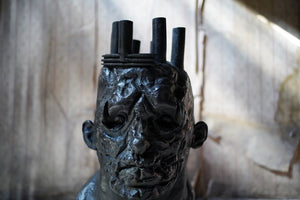Origin: English
Period: Late Victorian
Provenance: Unknown
Date: c.1900
Each Page: 7” x 4.5”
Hailing from the last quarter of the nineteenth century, the very scarce group of sixty six doubles or 132 single mugshot or police booking photographs, from an administrative ledger, showing each male prisoner in profile and head-on, via pasted down silver paper gelatin portrait photographs to eleven loose album leaves, accompanied with their alleged crime and with numbers, names or initials, handwritten in ink beneath, surviving in-tact from the turn of the nineteenth century.
The condition of the images is good with some small blemishes, and the paper with some tattiness and spotting with browned edgings, with some having a little silvering and slight fade. They would probably benefit from being framed in double sided frames or one side to each could be peeled away from the backing paper and so one would then have twenty-two sets to display.
The crimes alleged include;
Larceny (and receiving)
Burglary
Rape
Robbery with Violence
House-Breaking
Counterfeit Coin
Robbery with Violence
Forgery
Wounding
House Stealing
Arson
Pick-Pocket
Shop-Breaking
Cycle Stealing
Jewellery Stealing
Clothing Stealing
There are a few full names such as G. Wright and W.Glover but most are just initialled.
Mugshots were originally created because written descriptions were unreliable. A governor at the time these shots were taken said of the new method; “'Photography as an agent in discovering the antecedents of criminals, especially tramps and strangers, is unquestionably a very useful auxiliary and in my opinion should be brought into prison use generally.
Some experts say that the first photographs used for law enforcement were probably taken of prisoners in Belgium in 1843 and 1844, possibly so that the prisoners could be identified if they committed other crimes after being released. By 1857 the New York police had adopted the practice, opening a gallery so that the public could come in to see the daguerreotypes of “hookers, stooges, grifters and goons. “They offer a rare insight into the lower classes of the late 19th century, who were rarely photographed. Photographic portraits were expensive so the portraits which usually survive from this time are mainly of the gentry and middle classes who could afford them.”
Whether thieves, poachers, forgers or pickpockets, this group are very rare ephemera photography and prove to be utterly absorbing.
Period: Late Victorian
Provenance: Unknown
Date: c.1900
Each Page: 7” x 4.5”
Hailing from the last quarter of the nineteenth century, the very scarce group of sixty six doubles or 132 single mugshot or police booking photographs, from an administrative ledger, showing each male prisoner in profile and head-on, via pasted down silver paper gelatin portrait photographs to eleven loose album leaves, accompanied with their alleged crime and with numbers, names or initials, handwritten in ink beneath, surviving in-tact from the turn of the nineteenth century.
The condition of the images is good with some small blemishes, and the paper with some tattiness and spotting with browned edgings, with some having a little silvering and slight fade. They would probably benefit from being framed in double sided frames or one side to each could be peeled away from the backing paper and so one would then have twenty-two sets to display.
The crimes alleged include;
Larceny (and receiving)
Burglary
Rape
Robbery with Violence
House-Breaking
Counterfeit Coin
Robbery with Violence
Forgery
Wounding
House Stealing
Arson
Pick-Pocket
Shop-Breaking
Cycle Stealing
Jewellery Stealing
Clothing Stealing
There are a few full names such as G. Wright and W.Glover but most are just initialled.
Mugshots were originally created because written descriptions were unreliable. A governor at the time these shots were taken said of the new method; “'Photography as an agent in discovering the antecedents of criminals, especially tramps and strangers, is unquestionably a very useful auxiliary and in my opinion should be brought into prison use generally.
Some experts say that the first photographs used for law enforcement were probably taken of prisoners in Belgium in 1843 and 1844, possibly so that the prisoners could be identified if they committed other crimes after being released. By 1857 the New York police had adopted the practice, opening a gallery so that the public could come in to see the daguerreotypes of “hookers, stooges, grifters and goons. “They offer a rare insight into the lower classes of the late 19th century, who were rarely photographed. Photographic portraits were expensive so the portraits which usually survive from this time are mainly of the gentry and middle classes who could afford them.”
Whether thieves, poachers, forgers or pickpockets, this group are very rare ephemera photography and prove to be utterly absorbing.

















































